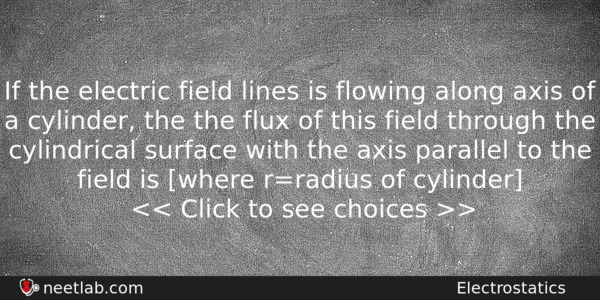| ⇦ | 
| ⇨ |
If the electric field lines is flowing along axis of a cylinder, then the flux of this field through the cylindrical surface with the axis parallel to the field is [where r=radius of cylinder]
Options
(a) σ/2πrε₀
(b) σ/ε₀
(c) zero
(d) σ/2ε₀
Correct Answer:
zero
Explanation:
As we have to find the electric flux through the cylindrical surface and we are given that the electric field is flowing along axis of cylinder.
So as we draw area vector on cylindrical surface it will make an angle of 90• by which the cos 90 will become 0 and ans would be 0
Related Questions: - A rod lies along the X-axis with one end at the origin and the other at x→∞. It carries
- The de-Broglie wavelength of an electron in the first Bohr orbit is
- The ratio of magnetic dipole moment of an electron of charge e and mass m
- If rope of lift breaks suddenly, the tension exerted by the surface of the lift
- In an orbital motion, the angular momentum vector is
Topics: Electrostatics
(146)
Subject: Physics
(2479)
Important MCQs Based on Medical Entrance Examinations To Improve Your NEET Score
- A rod lies along the X-axis with one end at the origin and the other at x→∞. It carries
- The de-Broglie wavelength of an electron in the first Bohr orbit is
- The ratio of magnetic dipole moment of an electron of charge e and mass m
- If rope of lift breaks suddenly, the tension exerted by the surface of the lift
- In an orbital motion, the angular momentum vector is
Topics: Electrostatics (146)
Subject: Physics (2479)
Important MCQs Based on Medical Entrance Examinations To Improve Your NEET Score
18000+ students are using NEETLab to improve their score. What about you?
Solve Previous Year MCQs, Mock Tests, Topicwise Practice Tests, Identify Weak Topics, Formula Flash cards and much more is available in NEETLab Android App to improve your NEET score.
Share this page with your friends

As we have to find the electric flux through the cylindrical surface and we are given that the electric field is flowing along axix of cylinder
So as we draw area vector on cylindrical surface it will make an angle of 90• by which the cos 90 will become 0 and ans would be 0
Thanks (Prateekpreet Madhukar)